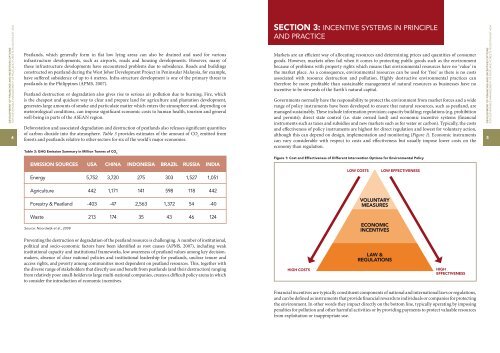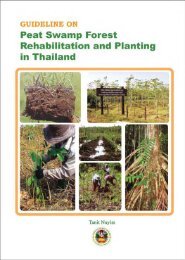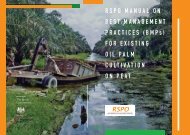Untitled - Peat Portal
Untitled - Peat Portal
Untitled - Peat Portal
You also want an ePaper? Increase the reach of your titles
YUMPU automatically turns print PDFs into web optimized ePapers that Google loves.
DEVELOPMENT OF FINANCING AND INCENTIVES OPTIONSFOR SUSTAINABLE MANAGEMENT OF PEATLAND FORESTS IN SOUTHEAST ASIA4<strong>Peat</strong>lands, which generally form in flat low lying areas can also be drained and used for variousinfrastructure developments, such as airports, roads and housing developments. However, many ofthese infrastructure developments have encountered problems due to subsidence. Roads and buildingsconstructed on peatland during the West Johor Development Project in Peninsular Malaysia, for example,have suffered subsidence of up to 4 metres. Infra-structure development is one of the primary threat topeatlands in the Philippines (APMS, 2007).<strong>Peat</strong>land destruction or degradation also gives rise to serious air pollution due to burning. Fire, whichis the cheapest and quickest way to clear and prepare land for agriculture and plantation development,generates large amounts of smoke and particulate matter which enters the atmosphere and, depending onmeteorological conditions, can impose significant economic costs to human health, tourism and generalwell-being in parts of the ASEAN region.Deforestation and associated degradation and destruction of peatlands also releases significant quantitiesof carbon dioxide into the atmosphere. Table 3 provides estimates of the amount of CO 2emitted fromforests and peatlands relative to other sectors for six of the world’s major economies.SECTION 3: IncENTIve SySTEMS in PRINcIPLEand PRAcTIceMarkets are an efficient way of allocating resources and determining prices and quantities of consumergoods. However, markets often fail when it comes to protecting public goods such as the environmentbecause of problems with property rights which means that environmental resources have no ‘value’ inthe market place. As a consequence, environmental resources can be used for ‘free’ as there is no costsassociated with resource destruction and pollution. Highly destructive environmental practices cantherefore be more profitable than sustainable management of natural resources as businesses have noincentive to be stewards of the Earth’s natural capital.Governments normally have the responsibility to protect the environment from market forces and a widerange of policy instruments have been developed to ensure that natural resources, such as peatland, aremanaged sustainably. These include information provision; capacity building; regulations (e.g. prohibitionand permits); direct state control (i.e. state owned land) and economic incentive systems (financialinstruments such as taxes and subsidies and new markets such as for water or carbon). Typically, the costsand effectiveness of policy instruments are highest for direct regulation and lowest for voluntary action,although this can depend on design, implementation and monitoring (Figure 1). Economic instrumentscan vary considerable with respect to costs and effectiveness but usually impose lower costs on theeconomy than regulation.DEVELOPMENT OF FINANCING AND INCENTIVES OPTIONSFOR SUSTAINABLE MANAGEMENT OF PEATLAND FORESTS IN SOUTHEAST ASIA5Table 3: GHG Emission Summary in Million Tonnes of CO 2EMISSION SOURCES USA ChINA INDONESIA BRAZIL RUSSIA INDIAEnergy 5,752 3,720 275 303 1,527 1,051Figure 1: Cost and Effectiveness of Different Intervention Options for Environmental PolicyLOW COSTSLOW EFFECTIVENESSAgriculture 442 1,171 141 598 118 442Forestry & <strong>Peat</strong>land -403 -47 2,563 1,372 54 -40VOLUNTARYMEASURESWaste 213 174 35 43 46 124Source: Noordwijk et al., 2008ECONOMICINCENTIVESPreventing the destruction or degradation of the peatland resource is challenging. A number of institutional,political and socio-economic factors have been identified as root causes (APMS, 2007), including weakinstitutional capacity and institutional frameworks, low awareness of peatland values among key decisionmakers,absence of clear national policies and institutional leadership for peatlands, unclear tenure andaccess rights, and poverty among communities most dependent on peatland resources. This, together withthe diverse range of stakeholders that directly use and benefit from peatlands (and their destruction) rangingfrom relatively poor small-holders to large multi-national companies, creates a difficult policy arena in whichto consider the introduction of economic incentives.HIGH COSTSLAW ®ULATIONSHIGHEFFECTIVENESSFinancial incentives are typically constituent components of national and international laws or regulations,and can be defined as instruments that provide financial rewards to individuals or companies for protectingthe environment. In other words they impact directly on the bottom line, typically operating by imposingpenalties for pollution and other harmful activities or by providing payments to protect valuable resourcesfrom exploitation or inappropriate use.





